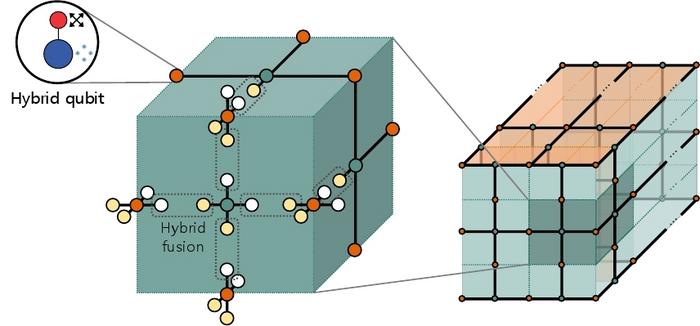KIST Develops Hybrid Quantum Error Correction, Merging the Power of DV and CV Qubits

Insider Brief:
- Dr. Seung-Woo Lee’s team at the Korea Institute of Science and Technology developed a hybrid quantum error correction architecture that integrates discrete variable and continuous variable qubits.
- The hybrid system combines the strengths of both qubit types to mitigate their individual weaknesses, using hybrid fusion techniques to create an error-correcting lattice structure, particularly relevant for improving performance in optical quantum computing.
- Numerical simulations showed the hybrid system can tolerate photon loss rates up to four times higher than existing methods and improves resource efficiency by 13 times while maintaining logical error rates.
- The research, a result of international collaboration with institutions like the University of Chicago, highlights the potential of hybrid technologies to support the development and commercialization of large-scale quantum computers.
Quantum error correction is widely accepted as a necessary component for building practical quantum computers. Errors in qubit manipulation can exponentially degrade the performance of quantum computations, making it important to mitigate these errors for quantum computing to effectively surpass its classical counterpart in relevant applications. Recent research from Dr. Seung-Woo Lee’s team at the Korea Institute of Science and Technology (KIST) published in PRX Quantum introduces a new hybrid quantum error correction architecture that integrates both discrete variable (qubits with distinct states) and continuous variable (qubits with a range of values) qubits into a cohesive system, in pursuit of improving fault tolerance in quantum systems.
This architecture is intentionally designed, as noted in the study, to overcome some of the limitations inherent in using DV and CV qubits independently, which have so far been used separately by companies such as IBM, Google, and Xanadu. The hybrid approach demonstrated by the KIST team may provide improvements in error correction, especially for optical quantum computing systems.
Hybrid Approach to Quantum Error Correction
Qubits are prone to errors due to environmental noise and operational imperfections. These errors, if uncorrected, affect the ability to achieve the computational advantages potentially possible by quantum computers. The research team led by Dr. Seung-Woo Lee developed a method to integrate quantum error correction for both DV and CV qubits, presenting a fault-tolerant quantum computing architecture that brings together the strengths of both qubit types.
According to the study, DV qubits are typically easier to manipulate and measure but are resource-intensive in terms of quantum error correction. CV qubits, on the other hand, offer a richer space for encoding quantum information and may provide more efficient error correction methods. However, they are more sensitive to loss, which impacts the accuracy of computations.
By combining these two types of qubits in a hybrid system, the researchers were able to develop an architecture that capitalizes on the advantages of both while mitigating their respective weaknesses. The hybrid qubits connect through what the study refers to as “hybrid fusion techniques,” creating an error-correcting lattice structure designed to tolerate common error types like photon loss.
Key Findings from the Numerical Simulations
The study highlights the results of numerical simulations that demonstrate the hybrid architecture’s performance compared to traditional quantum error correction schemes. According to the researchers, the hybrid system can tolerate photon loss rates up to four times higher than existing techniques, a notable improvement for optical quantum systems, where photon loss is a major error source.
Moreover, the hybrid approach improves resource efficiency by 13 times while maintaining a consistent level of logical error rates. This efficiency boost is relevant for scaling quantum systems toward practical use cases, where resources are often a limiting factor.
Dr. Jaehak Lee from KIST emphasized the versatility of the new architecture, noting that while it is particularly well-suited for optical quantum computing, the hybrid error correction technique could also be applied to other systems, including superconducting and ion trap quantum computers. This adaptability opens the door for further exploration in various quantum platforms.
Collaborative Efforts and Future Implications
This research builds on an ongoing collaboration between KIST and international institutions such as the University of Chicago and Seoul National University. In March of the previous year, KIST signed a memorandum of understanding with the University of Chicago. The hybrid quantum error correction technique is a direct result of this partnership, which has demonstrated the potential for developing technologies that could lead the field in quantum computing.
“Hybrid technologies that integrate the advantages of different platforms are expected to play a crucial role in developing and commercializing large-scale quantum computers,” said Dr. Seung-Woo Lee, speaking on the importance of this achievement.
The hybrid quantum error correction architecture presented by KIST may contribute to the future of building fault-tolerant quantum computers. By combining DV and CV qubits, the researchers have managed to create a more resource-efficient system that provides improved error correction capabilities.
As quantum technologies continue to evolve, integrating different quantum platforms in hybrid architectures could become a common strategy for overcoming the limitations of individual systems. The research from KIST and its collaborators also exemplifies the growing importance of international cooperation in advancing quantum computing technologies.
Contributing authors on the study include Jaehak Lee, Nuri Kang, Seok-Hyung Lee, Hyunseok Jeong, Liang Jiang, and Seung-Woo Lee.
